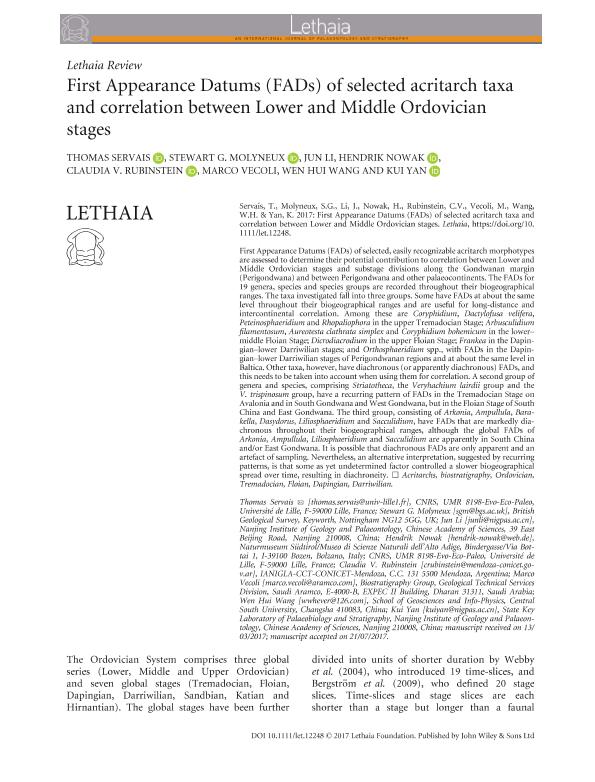Artículo
First Appearance Datums (FADs) of selected acritarch taxa and correlation between Lower and Middle Ordovician stages
Servais, Thomas; Molyneux, Stewart G.; Li, Jun; Nowak, Hendrik; Rubinstein, Claudia Viviana ; Vecoli, Marco; Wang, Wen Hui; Jan, Kui
; Vecoli, Marco; Wang, Wen Hui; Jan, Kui
 ; Vecoli, Marco; Wang, Wen Hui; Jan, Kui
; Vecoli, Marco; Wang, Wen Hui; Jan, Kui
Fecha de publicación:
04/2018
Editorial:
Wiley Blackwell Publishing, Inc
Revista:
Lethaia
ISSN:
0024-1164
Idioma:
Inglés
Tipo de recurso:
Artículo publicado
Clasificación temática:
Resumen
First Appearance Datums (FADs) of selected, easily recognizable acritarch morphotypes are assessed to determine their potential contribution to correlation between Lower and Middle Ordovician stages and substage divisions along the Gondwanan margin (Perigondwana) and between Perigondwana and other palaeocontinents. The FADs for 19 genera, species and species groups are recorded throughout their biogeographical ranges. The taxa investigated fall into three groups. Some have FADs at about the same level throughout their biogeographical ranges and are useful for long-distance and intercontinental correlation. Among these are Coryphidium, Dactylofusa velifera, Peteinosphaeridium and Rhopaliophora in the upper Tremadocian Stage; Arbusculidium filamentosum, Aureotesta clathrata simplex and Coryphidium bohemicum in the lower–middle Floian Stage; Dicrodiacrodium in the upper Floian Stage; Frankea in the Dapingian–lower Darriwilian stages; and Orthosphaeridium spp., with FADs in the Dapingian–lower Darriwilian stages of Perigondwanan regions and at about the same level in Baltica. Other taxa, however, have diachronous (or apparently diachronous) FADs, and this needs to be taken into account when using them for correlation. A second group of genera and species, comprising Striatotheca, the Veryhachium lairdii group and the V. trispinosum group, have a recurring pattern of FADs in the Tremadocian Stage on Avalonia and in South Gondwana and West Gondwana, but in the Floian Stage of South China and East Gondwana. The third group, consisting of Arkonia, Ampullula, Barakella, Dasydorus, Liliosphaeridium and Sacculidium, have FADs that are markedly diachronous throughout their biogeographical ranges, although the global FADs of Arkonia, Ampullula, Liliosphaeridium and Sacculidium are apparently in South China and/or East Gondwana. It is possible that diachronous FADs are only apparent and an artefact of sampling. Nevertheless, an alternative interpretation, suggested by recurring patterns, is that some as yet undetermined factor controlled a slower biogeographical spread over time, resulting in diachroneity.
Palabras clave:
Acritarchs
,
Biostratigraphy
,
Dapingian
,
Darriwilian
,
Floian
,
Ordovician
,
Tremadocian
Archivos asociados
Licencia
Identificadores
Colecciones
Articulos(IANIGLA)
Articulos de INST. ARG. DE NIVOLOGIA, GLACIOLOGIA Y CS. AMBIENT
Articulos de INST. ARG. DE NIVOLOGIA, GLACIOLOGIA Y CS. AMBIENT
Citación
Servais, Thomas; Molyneux, Stewart G.; Li, Jun; Nowak, Hendrik; Rubinstein, Claudia Viviana; et al.; First Appearance Datums (FADs) of selected acritarch taxa and correlation between Lower and Middle Ordovician stages; Wiley Blackwell Publishing, Inc; Lethaia; 51; 2; 4-2018; 228-253
Compartir
Altmétricas



